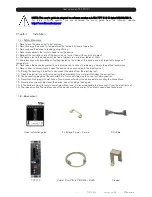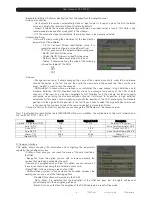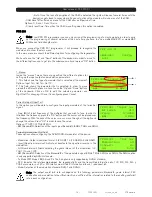
User’s manual · TFF 310 CI
- 9 - TFF 310 CI version_en_2.0 FTE maximal
- Bandwidth limitation: It allows selecting the % of the capacity of the output channel.
- Auto service addition:
- On: It selects the services automatically when an input carrier is tuned and when the list of selected
services is empty. The receiver will have this state by default.
- Always: It selects the services automatically every time a new input carrier is tuned. This state is only
recommended to be used for making test in the module.
- Off: The automatic mode is deactivated; the services have to be manually selected.
- Advanced settings:
- Network: It allows making the adjustment of the identification
parameters of the multiplex.
- TS ID: Transport Stream identification value. It is
recommended to configure a value different from
TS ID for each one of the output multiplex configured.
- Net ID: Net identification value
- Original Net ID: Original net identification value
- Network Name: Name associated with the net.
- Tables: It allows modifying the value of the following
information tables of the DVB:
- NIT
- SDT
- PAT
- Services:
- Change service name: It allows changing the name of the service manually. In order to do so, please
choose the service in the first line and then write the new name in the second line. Then you have to
press “modify” in order to save the changes.
- HDSimulCast: In cases where we receive in an installation the same channel in high definition and in
standard definition, the HD Simulcast function allows to exchange the position of the LCN of both
channels. If the user has a device compatible to HD Simulcast and the module has been correctly
configured, when tuning the standard definition channel, it will move to its position in high definition
automatically. This option allows modifying manually the position of the LCN, exchanging the standard
position into the high definition position. In the first line you have to select the high definition service and
in the second line you have to select the same service but in standard definition.
- Change in Service ID: From this position you can change the PID Number of the chosen service.
Next it is attached the identification table (NID/ONID) of the main satellites. You will be able to find more information in
the law ETSI TR 101 162 v1.2.1.
Satellite
Net ID
Original Net ID
Description
Hotbird 13ºE (Eutelsat 13ºE)
318
318
Eutelsat 13ºE System
Astra 19.2ºE
1
1
Astra Satellite Network 19,2ºE
Astra 23ºE
3-25
3-25
Astra n (n=1-23)
Astra 28,2ºE
2
2
Astra Satellite Network 28,2ºE
Nilesat 7ºW
2048
2048
Nilesat 101
Hispasat 30ºW
33
33
Hispasat Network 1
9. Common Interface
This option allows checking the information and configuring the parameters
regarding the conditional access.
- CI Menu: From here you can reach the menu of the card inserted in
the CAM.
- Decryption: From this option you can add or remove manually the
services that are being decoded by the card.
- Remove all decrypted services: From this option you can remove all
the services that are decoding the conditional access card.
- Reset CAM: It allows making a reset in the CAM.
- CAM watchdog system: In cases where the encoded services stop
working you can use one of the following options.
- Disabled: No actions will me made in the CAM.
- Retry: When it is detected that the decryption of the CAM has been lost, the rights will be sent
systematically until the decryption gets back.
- Reset: As soon as the loss of decryption of the CAM is detected, a reset will be made.
Summary of Contents for TFF 310 CI
Page 1: ...TFF 310 CI USER S MANUAL...










































